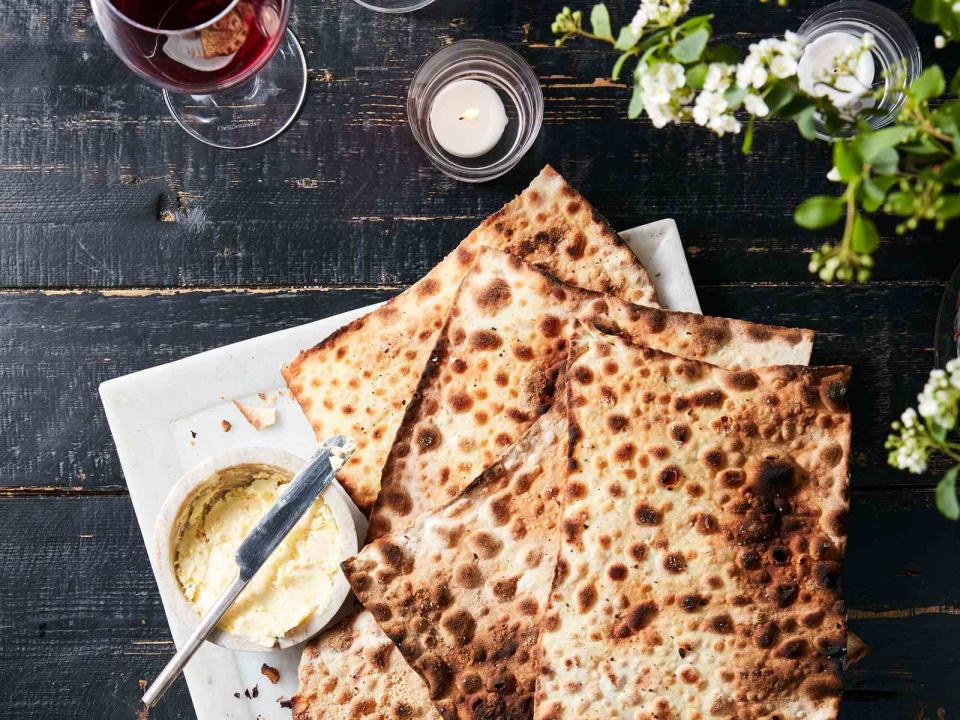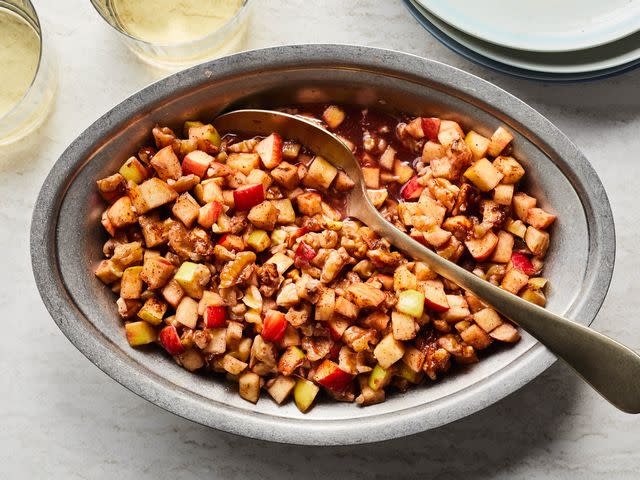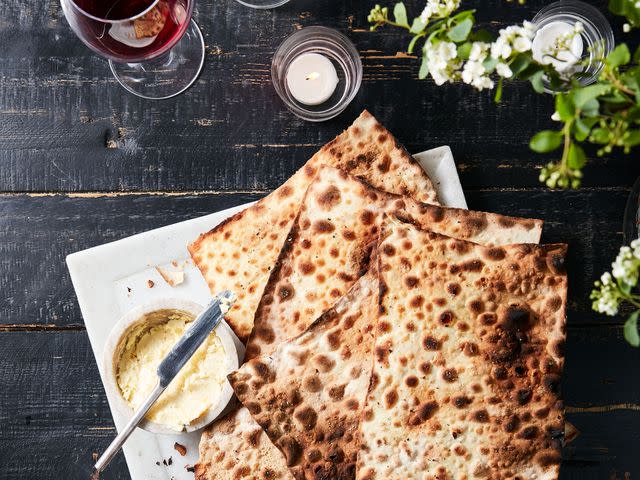How to Make the Best Passover Seder Plate
Upgrade your Passover feast with these traditional and modern Seder plate items.

Passover might be the best holiday for food. Not only is the Seder full of some of the homey, delicious dishes that define Jewish cuisine like brisket and matzo ball soup, but each portion of the meal is there for a reason. A Passover Seder is both a meal and a ceremony that tells the story of the Jews who fled from Egypt to escape slavery. Nearly every portion of the meal is a symbol for how our ancestors overcame adversity. The Seder plate, the centerpiece of the Passover dinner table, is no exception, holding six edible connections to the story of Exodus.
Now, this all sounds very serious. But really, Passover is about celebration — sharing a meal with loved ones, relaxing (you’re literally supposed to recline in your chair to be as comfortable as possible), and toasting what we have now. So even though the holiday is important and quite structured, there’s more than enough room to make it your own, starting with the pièce de résistance: the Seder plate. Different sects of Judaism celebrate Passover in slightly different ways, so there is no single correct celebration, but all types include some form of Seder plate. This is what's included and why:
What goes on a Seder plate
Decorate your plate with the six symbolic ingredients, all of which can be prepped the night before. Here’s what you need:
Charoset

Translating to “clay” in English, the often sticky charoset (sometimes spelled haroset) symbolizes the bricks and mortar used by enslaved Israelites to build pyramids. The condiment can vary depending on the region — Ashkenazi Jews typically eat a combination of chopped apples, walnuts, cinnamon, and honey (not too dissimilar from apple pie filling) while Sephardic charoset is more dippable, eliminating the apple, swapping walnuts for almonds, and adding dried dates, apricots, and/or raisins. No matter how you decide to make it, throw it on some matzo for a crunchy, fruity, mid-meal snack.
Beitzah (roasted egg)
The roasted or boiled egg means a lot of things: It represents the festival sacrifice to God at the temple of Jerusalem, it’s a reminder to mourn (as hard-boiled eggs are often served after a Jewish funeral), it symbolizes rebirth, and the round shape points to the circle of life and new beginnings. It’s pretty difficult to split the single egg on the plate among everyone at the table, so maybe save your Seder egg for later and use it to make this Passover-friendly egg salad.
Zeroah (roasted bone)
Similar to the beitzah, a roasted bone is placed on the Seder plate to symbolize the paschal sacrifice of a lamb made the night before the Exodus. A lamb shank is traditionally used — the lamb bone is a reminder that lambs’ blood was painted on the door jambs of the Jews during the Plagues to prevent the killing of the firstborn — but you can swap it for a turkey or chicken neck, or any bone you have on hand. Either roast it over an open flame or in a 450°F oven until it has browned on all sides. Feel free to save the bone to use later in order to fortify a broth … for matzo ball soup, perhaps?
Maror (bitter herbs)
The most literal of all the Seder plate ingredients, bitter herbs are included to represent the bitterness of slavery. Usually this takes form as horseradish. You can keep it simple and just use whole horseradish root, or grate the horseradish so you can use it as a spicy condiment to balance the charoset. You may also want to incorporate horseradish into the meal itself, like in Gail Simmons’ horseradish brisket.
Chazeret (lettuce)
Chazeret is simply used as an additional bitter herb. The Haggadah (the book read during Passover) instructs us to eat matzo with “bitter herbs.” Taking this commandment extremely literally, we add a second source of bitterness – usually romaine lettuce or endive — to the Seder plate. Some Ashkenazi Jews include it as part of the Hillel sandwich, a sandwich of matzo, charoset, and bitter herbs that is eaten during the service.
Karpas (green vegetable)
Parsley, or another green vegetable, is on the plate to represent the initial flourishing of the Jews in Egypt before they became enslaved, and continued hope and renewal. During the Seder, we’re instructed to dip the parsley into salt water to symbolize the tears that were shed and the hardships that the Hebrew slaves were forced to endure. The flavor of parsley is often associated with Passover, so consider making a fresh parsley salad to brighten up the meal.
If you or your hosts are of Eastern European descent, karpas might be represented with a piece of potato, as green vegetables were less available in those Ashkenazi communities during the Passover season. Additionally, these days, the presence of a potato on the Seder plate can also be a representation and acknowledgement of Ethiopian Jewry, since when Ethiopian Jews arrived in Israel, many were too ill to be able to eat anything but potatoes.
Matzo
Matzo is not placed on the Seder plate but is stacked on a special plate nearby and is also part of the ceremony. This unleavened cracker-like bread is said to represent the bread the Jews took with them on the Exodus. They did not have time to let their bread rise, so they quickly baked matzo. Matzo for Passover must pass strict kosher guidelines, which have time limits between dough being created and baked, to ensure that no wild yeasts allow any rising of the dough. Since one of the dietary rules of Passover is to avoid bread or any food that rises or is leavened, observants eat matzo throughout the week of Passover, for Matzo Brei, as a streusel topping, as the base for a tartine, or as a part of a tasty snack.

Modern symbols on the Seder plate
Contemporary traditions have been adopted into the Passover service over the years. Some families add an orange to the Seder plate to symbolize the role of women and the LGBTQ community in Jewish life. The orange represents the literal fruitfulness these people bring into our lives and faith. Each person eats a segment of the orange to represent solidarity, and the act of spitting out the seeds is a repudiation of misogyny, homophobia, and transphobia.
That’s not the only addition to the Seder plate. Adding an olive represents the hope for peace between Israelis and Palestinians, since an olive branch is a symbol of peace. Cashews on the Seder plate honor military troops, since cashews are an important part of the diet for military personnel serving in desert climates.
If your hosts have a piece of chocolate or a cacao bean on the Seder plate, they are acknowledging the need for fair trade practices, and as a reminder that while the Jews are no longer enslaved in Egypt, slavery and forced labor still continue today.
An acorn on the Seder plate can be a reminder to include conversation about indigenous issues facing our world and a reminder to seek to repair the harm that has come to those communities.
Finally, since 2015, when the image of the drowned body of three-year-old Aylan Kurdi on a Turkish shore was seen all over the world, some celebrants add a banana to represent refugees enduring their own contemporary Exodus; bananas were a special treat for Aylan and his brother Galip, who also lost his life escaping Syria.
Evolving traditions like these show that Passover, while an ancient ritual for Jewish people all over the world, is a celebration and feast that is open and dynamic. It honors the past and acknowledges the present while hoping for a better future for all. It is considered a particular mitzvah to have a non-Jew at the Seder, so if you are a Gentile and a Jewish friend or colleague has invited you to join their celebration, know that attending brings a special blessing to your host.
Related: 15 Passover Recipes for a Delicious Seder
Pick your plate
As long as it has enough space for six items, the look and style of the Seder plate is completely up to you. You can find something that has six divots or bowls, specifically designed to hold the items — it prevents the ingredients from moving around and gives the plate an air of idiosyncrasy. Here are a few favorites:
1. Nina Bönnelyche Illustrated Seder Plate
Handmade by Swedish artist Nina Bönnelyche, this ceramic platter-and-dish combo is traditional meets modern. The small bowls, each sketched with colorful images of their corresponding ingredient, are packaged separately so you can repurpose the large, blue-gray platter for any upcoming dinner party.
2. Michael Aram Pomegranate Seder Plate
This gold-toned enamel plate is modeled after a branch of pomegranates, a fruit that symbolizes righteousness and rebirth in Judaism. Michael Aram’s design is so beautiful that it could easily remain on the center of your table year-round.
3. SIND Studio Passover Seder Plate
Made to order, no SIND Studio Seder plate is exactly the same. The porcelain dish and bowls are chic and glossy with a sophisticated gold rim. It’s the ultimate way to add a splash of style to your Seder.
4. DAYS Designer Star Seder Plate
DAYS’ creative design is just as much of a Seder plate as it is a puzzle. The wooden blocks, each carved with an item written in English and Hebrew, can be built to fit around a star of David, or taken apart and put back together in any shape that floats your boat.
For more Food & Wine news, make sure to sign up for our newsletter!
Read the original article on Food & Wine.

